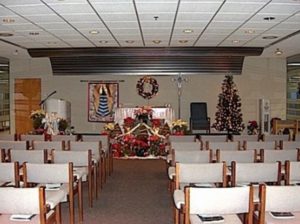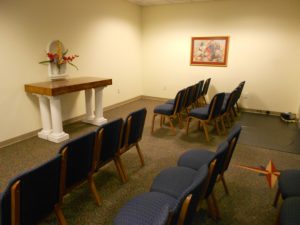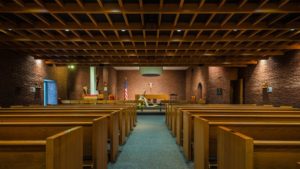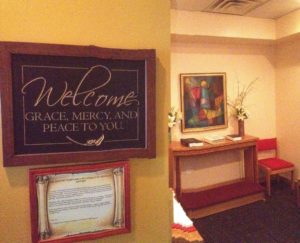AIRPORT CHAPELS TIMELINE
1951: The Archdiocese of Boston opened the first airport chapel in the United States, which was Catholic, at Logan airport.
1955: Mass began in the United States’ second airport chapel, also Catholic, in New York City.
1958: The Protestant Council of the City of New York and the New York Board of Rabbis reached agreements to practice alongside the Catholic guild.
Early 1960s: Several other Catholic airport chapels were opened in cities with large Catholic populations.
1967: Ten Catholic airport priests met in Brussels, beginning an annual tradition that morphed into a multireligious professional association known as the International Association of Civil Aviation Chaplains.
1970: “Pontificia Commissio de Spirituali Migratorum atque Itinerantium Cura” was established by Pope Paul VI to study and provide pastoral care to people on the move including air travelers.
1980: In Atlanta, the Interfaith Airport Chaplaincy was formed with an initial board of directors that included one Protestant, one Catholic, and one Jew. A very small chapel was formed soon after.
1980s: Airport chapels in Dallas were much smaller and far more Protestant in design than the Catholic chapels of other airports across the country.
Late 1980s-Early 2000s: Several airport chapels, including in Phoenix, San Francisco, Denver, and Detroit, became more religiously inclusive; interfaith sites became more common and chapels started to welcome Muslim practice.
2018: Sixteen of the twenty largest U.S. airports have some kind of chapel or meditation space today, most of which differ quite significantly from one another.
FOUNDER/GROUP HISTORY
More than 250,000 passengers and 30,000 employees pass through Hartsfield-Jackson International Airport in Atlanta every day. Like a small city, the airport complex covers 6.8 million square feet and has several fire departments, a hairdresser, a walk-in health clinic, food available 24/7, and, since 1981, a chapel (ATL Fact Sheet, n.d.). Today there are three chapels, two on the secure side and one before passengers pass through security. People moving through the airport might converse with Chester Cook, one of two airport chaplains who receive financial support or one of forty chaplaincy volunteers. If passengers fly from Atlanta to New York’s JFK airport, Boston’s Logan airport, or Chicago’s O’Hare airport, they might see Catholic airport chapels or Catholic priest-chaplains when they land. If they fly to Denver International, Seattle-Tacoma International, or a range of other large American cities, they will find multifaith chapels, some staffed by chaplains or volunteers and others not staffed at all.
Since 1951, when the Archdiocese of Boston opened the first airport chapel in the United States, tensions around the appropriate place for religion, and increasingly spirituality, in such spaces have been ongoing. Airports chapels are today quite varied in physical appearance, financial resources, and in the rules that govern how travelers and staff use them. Most Americans know little about airport chapels or the chaplains present in many airports, despite their growing numbers. Few are aware of the Fellowship of Christian Airport Personnel, growing numbers of airport yoga rooms, or the ways some airports accommodate Muslim cab drivers by being sure they have a dry (if not warm) place to pray (Clancy 2004; Lloyd 1998; Matier and Ross 2013; “US Airport Accommodates” 2013; White 2015). Although the growth of airport chapels might have seemed like a unified trend, these chapels are all very different from one another without set doctrines and beliefs.
The earliest airport chapels were Catholic in design. In addition to the ones in Boston and New York, several other Catholic airport chapels were opened in the 1960s in response to requests from Catholic workers in cities with large Catholic populations. Mirroring changes in the Catholic church following Vatican II, these chapels brought the Mass in English to workers in their workplaces. In Chicago, Michael Zaniolo, the Catholic priest-chaplain at Chicago’s O’Hare airport, explains that Catholics working at the airport on twenty-four hour shifts in the early 1960s “asked a priest at the neighboring parish if he would come over and say mass for them. . . .at that time the police had 24 hour shifts, the firemen had 24 hour shifts and the  airlines had rotating shifts.” This priest had what Father Zaniolo jokingly called “jet fuel” in his blood, and he continued celebrating mass, baptizing babies, and marrying people until staff petitioned the cardinal to have him appointed to the airport full time in 1966 (M. Zaniolo, personal interview, July, 2013). At this time, the cardinal also set up the O’Hare Airport Chapel [Image at right] as a kind of nonresidential parish where Catholics could receive the sacraments and have access to a priest.
airlines had rotating shifts.” This priest had what Father Zaniolo jokingly called “jet fuel” in his blood, and he continued celebrating mass, baptizing babies, and marrying people until staff petitioned the cardinal to have him appointed to the airport full time in 1966 (M. Zaniolo, personal interview, July, 2013). At this time, the cardinal also set up the O’Hare Airport Chapel [Image at right] as a kind of nonresidential parish where Catholics could receive the sacraments and have access to a priest.
A similar process took place at the Newark International Airport when Catholic employees of Pan Am airlines recruited a local Catholic priest to offer Mass. They built an altar on wheels that was stored in the closet of an airport restaurant when not in use. A Catholic priest-chaplain was formally appointed though it was not until the 1990s that he was able to secure space for a chapel, in part due to the generosity of one of the airlines in whose terminal it is located (D. Baratelli, personal interview, September, 2013). There is no evidence of controversy in any of these cases or demands for chapel spaces or chaplains for people in addition to Catholics. Perhaps this suggests the general acceptance of religion or the specific ritual needs Catholics had for the Mass distinct from the needs of Protestants and Jews at the time as well as distinct demographic realities in cities with large Catholic populations.
By the end of the 1960s, a handful of American airports had chapel spaces, the majority of which were started by Catholics for Catholic workers and travelers. While non-Catholics had built airport chapels at JFK and also in Denver, Houston, and a few other cities, it was Catholics during this period who perhaps most needed liturgical space for mass and/or had the infrastructure, funds, and people to provide such spaces. Such developments parallel and in some ways embody changes in Vatican II designed to bring mass to lay Catholics in as accessible a way as possible. The local congregations that developed around the Protestant, Catholic, and Jewish chapels at JFK during this period were unusual and not a model for how more multifaith chapels would develop in other cities in coming decades.
The declining significance of denominationalism and the growth of evangelical Christianity influenced the shape of airport chapels mostly started by Protestants in the 1970s and 1980s. Such broad changes enabled Protestants to work together across denominational lines, particularly when linked by evangelical worldviews. Distinct from the centralized structure of the Catholic church, resources were often a challenge as were local negotiations with airport officials about physical space. Groups of local religious leaders or single individuals with specific (idiosyncratic) passions for the ministry tended to take the lead in these years creating chapel spaces (and chaplaincies) oriented more toward quiet prayer and individual reflection than organized religious services, such as those for Catholics.

In Atlanta, for example, the first airport chapel [Image at right] was created in the early 1970s, but it was not until the 1980s that there was a sustained chaplain presence. Mayor Maynard Jackson granted space to a single individual and a Christian Council of Metropolitan Atlanta. An airport chapel was opened but quickly closed because the council did not have ongoing staff or resources to maintain it. In the spring of 1980, a distinctly interfaith group incorporated as the Interfaith Airport Chaplaincy under Georgia law with an initial board of directors that included one Protestant, one Catholic, and one Jew. They convinced one of the airlines to donate space for a small chapel that Chester Cook, the current chaplain, remembers as a “very small room” that was “multipurpose” and “didn’t have a slant toward any one religion” (C. Cook, personal interview, August, 2013). In 1981, a dedicated Protestant chaplain began to develop the chaplaincy at the airport (Airport Chaplaincy Program 2017).
At the Dallas airport, the chaplaincy was incorporated as a 501(c)(3) organization in 1977 and opened a small chapel in the late 1970s that was demolished and rebuilt several years later in a new location after a major airline closed. Two other small chapels were also opened in different terminals of the Dallas airport in the 1980s. These spaces have tended to have altars, podiums, chairs or pews, and in some cases stained glass windows. While they were intended to be welcoming to all, they were more traditionally Protestant in design and appearance than chapels started by Catholics at other airports, and they were smaller (not large enough for a large service or Mass) (DFW Airport n.d.).
Unlike the interfaith chapel spaces in Atlanta, the shared but Protestant-oriented space in Dallas, or the counseling spaces in Minneapolis, the Protestant-Catholic-Jewish model of separate chapel spaces (and chaplaincies) remained at JFK until the mid-1980s when the chaplaincy’s lease to the land ended and the chapels were demolished to make way for airport expansion. The expansion plan called for the chapels to be consolidated into a single interfaith space built far from the main terminal building, perhaps because the three congregations had dwindled and there was little contact between the chaplains and traveling public. The Protestant, Catholic, and Jewish chaplains did not like this plan and did not want to be further disconnected from the airport by physical distance. So, they agreed to share a small interim interfaith chapel in the international arrivals hall of the airport. This shared chapel was decorated with some items from the original chapels and remained in use until the early 2000s when four separate rooms were opened side-by-side in the same location for Protestants, Catholics, Jews, and Muslims (though the space is formally called a multifaith chapel). Today the chaplains have a twenty-five-year lease but do not pay for their space in the airport (Bayowski 2005; C. Piasta, personal interview, September, 2013).
The last decade of the twentieth century and early 2000s witnessed the rise of more religiously inclusive chapels both in efforts to create spaces welcoming to all and in distinct areas for Muslim prayer. Such changes reflect growing public awareness of religious diversity, growing public awareness of Islam especially after 9/11, and growing awareness of actual and potential conflicts over religion in public settings.
DOCTRINES/BELIEFS

The physical appearance of chapels today varies as the history to date suggests. At one end of a continuum are the Catholic chapels that remain in Boston, [Image at right] New York’s JFK, and Chicago’s O’Hare where the historically Catholic roots of airport chaplaincy remain strong. These airports each have a large Catholic-oriented chapel that seats many people for mass and is staffed by a chaplain-priest, appointed and paid by the local diocese. While little has changed in Boston and JFK, the chaplaincy at O’Hare transitioned informally in the 1980s and more formally in the early 1990s from control by the Catholic church to being formally run by the multifaith O’Hare Interfaith Chapel Corporation (M. Zaniolo, personal interview, July, 2013). Services from a range of religious traditions take place in that chapel and a sign on the door explains, “The chapel is open to all for quiet meditation, reflection, prayer and scheduled worship services.” Several journalists have called the single-faith Catholic airport chapels a “dying breed” (Filmore and Rubin 2008; Walker 2009).
At the other end of a continuum are airports that have removed, or never had, symbols from specific religious traditions in their chapels and typically call them meditation rooms, quiet seating areas, or reflection rooms (Airport Chapels 2005). The chapels in the Atlanta airport aim to be such spaces. Most are small rooms with a few chairs and clear glass. There are no religious objects except for sacred texts from a range of religious traditions.
 In between these two poles are chapels that include religious symbols and objects from a range of religious traditions. The “Chapel (Meditation Room)” at the Charlotte Douglas Airport [Image at right] is one such space. Located above a Cinnabon, the chapel is a small rectangular space entered through a door with a small stained glass window and image of a person kneeling in prayer. Multiple religious texts are inside alongside prayer rugs, rosary beads, and artistically rendered quotes from the world’s major religions. Pamphlets on topics ranging from grief to forgiveness are available for visitors to take with them and signs about services and ways to locate chaplains or volunteers figure prominently. In Charlotte, the airport management was clear that they would only lease chapel space to a nonprofit nondenominational group. This requirement led what had begun as an unofficial relationship between the airport and Catholic Diocese of Charlotte to expand to include people from a range of other traditions and the chapel that resulted to have a more multifaith approach (G. Szalony, personal interview, July, 2013).
In between these two poles are chapels that include religious symbols and objects from a range of religious traditions. The “Chapel (Meditation Room)” at the Charlotte Douglas Airport [Image at right] is one such space. Located above a Cinnabon, the chapel is a small rectangular space entered through a door with a small stained glass window and image of a person kneeling in prayer. Multiple religious texts are inside alongside prayer rugs, rosary beads, and artistically rendered quotes from the world’s major religions. Pamphlets on topics ranging from grief to forgiveness are available for visitors to take with them and signs about services and ways to locate chaplains or volunteers figure prominently. In Charlotte, the airport management was clear that they would only lease chapel space to a nonprofit nondenominational group. This requirement led what had begun as an unofficial relationship between the airport and Catholic Diocese of Charlotte to expand to include people from a range of other traditions and the chapel that resulted to have a more multifaith approach (G. Szalony, personal interview, July, 2013).
RITUALS/PRACTICES
Of the twenty largest American airports today, sixteen have permanent chapel spaces that reveal a range of approaches to contemporary American religion and spirituality. Airports in Las Vegas, Los Angeles, Philadelphia, and New York’s LaGuardia do not have chapel spaces though representatives in Philadelphia seriously considered opening such a space just after 9/11 as a way of caring for the traveling public (Hardaway and Spensley 1991; O’Reilly 2001; Toobin 2008). A Catholic chaplain at LaGuardia holds mass in a conference room and hopes to have a permanent space in the future. The number of chapels in individual airports varies with Dallas having five; JFK four; Atlanta three; Detroit, Denver and Houston two; and the remaining airports one. These spaces are today mostly called “Interfaith Chapel” or “City Name Airport Chapel” though a few are called meditation or reflection rooms and the Catholic chapels at JFK, Boston’s Logan and Chicago’s O’Hare maintain their formal “Our Lady” names. Most spaces are designated on airport maps by a symbol of a person bent in prayer. About half of the chapels are on the pre-security side of the airport and the other half accessible only after passengers pass through security, reflecting changes post 9/11 that make access to these spaces more challenging.
ORGANIZATION/LEADERSHIP
Ten Catholic airport priests met in Brussels in 1967 and have continued meeting annually eventually evolving into a multireligious professional association, the International Association of Civil Aviation Chaplains. Their work was strengthened by the “Pontificia Commissio de Spirituali Migratorum atque Itinerantium Cura” established by Pope Paul VI in 1970 to study and provide pastoral care to people on the move including air travelers (Pontifical Council, n.d.). The civil aviation branch of the resulting Pontifical Council for the Pastoral Care of Migrants and Itinerant People has been active developing materials, training chaplains, and providing various types of support since that time (Civil Aviation, n.d.). In the United States, Catholic chaplains created the National Conference of Catholic Chaplains, which meets regularly and publishes materials including a Catholic handbook for airport chaplaincy (Airport Chaplaincy 2011). However, most airport chapels operate independently from one another and employ a wide range of organizational models.
ISSUES/CHALLENGES
The need for increased religious inclusion is an ongoing issue as many airport chapels are beginning to adopt a more holistic and multifaith approach. However, with the growing trend of multifaith practice, airport chapels must also find a balance between maintaining their integrity and sacred nature while remaining welcoming to all. Furthermore, when it comes to balancing, airports and chaplains alike have to be extremely cautious about preserving the divide between church and state when dealing with their respective chapels.
Another important issue to consider is that no two airports have negotiated religion and spirituality in the same way, and what is permissible in one city is often not in another. Airport chapels as a whole are extremely localized and fragmented without any form of central organization. Consequently, religious practice, evolving beliefs and conflicts are all handled independently across airports.
IMAGES
Image #1: Chapel at O’Hare airport in Chicago, Illinois.
Image #2: Chapel at Hartsfield-Jackson Atlanta International Airport in Atlanta, Georgia.
Image #3: Chapel at Logan airport in Boston. Massachusetts.
Image #4: Chapel (Meditation Room) at Charlotte Douglas Airport in Charlotte, North Carolina.
REFERENCES *
*Adapted from Religion and American Culture: A Journal of Interpretation, Vol. 28, Issue 1, pp. 135–165, ISSN: 1052-1151, electronic ISSN: 1533-8568. © 2018 by The Center for the Study of Religion and American Culture. All rights reserved. Please direct all requests for permission to photocopy or reproduce article content through the University of California Press’s Reprints and Permissions web page,
Airport Chapels: Shifting from Denominational to Interfaith. 2005. Accessed from http://pluralism.org/research-report/airport-chapels-shifting-from-denominational-to-interfaith/ on 10 June 2018.
Airport Chaplaincy: A Catholic Handbook. 2011. United States: National Conference of Catholic Airport Chaplains.
Airport Chaplaincy Program. 2017. Accessed from https://archatl.com/ministries-services/airport-chaplaincy-program/ on 10 June 2018.
ATL Fact Sheet. n.d. Accessed from http://www.atl.com/about-atl/atl-factsheet/ on 10 June 2018.
Bayowski, Chad. 2005. Exploring Interfaith Space: The Chapel(s) at J.F.K. International Airport.
Civil Aviation – Pontifical Council for the Pastoral Care of Migrants and Itinerant People. n.d. Accessed from http://www.vatican.va/roman_curia/pontifical_councils/migrants/s_index_civilaviation/rc_pc_migrants_sectioncivilaviation.htm on 10 June 2018.
Clancy, Michael. 2004. “Airport Answers Prayers.” Arizona Republic, May 20.
DFW Airport Interfaith Chaplaincy. n.d. Accessed from http://www.dfwairportchapel.org/home.html on 10 June 2018.
Filmore, Janet, and Rubin, Jonathan. 2008. “Single-Faith Chapels a Dying Breed at U.S. Airports.” Christian Index, July 1.
Hardaway, Robert, and Spensley, James. 1991. Airport Regulation, Law, and Public Policy: The Management and Growth of Infrastructure. New York: Quorum Books.
Lloyd, Jillian. 1998. “Religious Practices v. Work Demands.” Christian Science Monitor, December 31.
Matier, Phil, and Ross, Andy. 2013. “Airport’s Garage Now a Muslim House of Worship.” San Francisco Chronicle, June 9.
O’Reilly, David. 2001. “Airport Speeds up Plans for Chapel.” Philadelphia Inquirer, October 21.
Pontifical Council for the Pastoral Care of Migrants and Itinerant People. n.d. Accessed from http://www.vatican.va/roman_curia/pontifical_councils/migrants/index.htm on 10 June 2018.
Toobin, Jeffrey. 2008. The Nine: Inside the Secret World of the Supreme Court. New York: Anchor Books.
“US Airport Accommodates Muslim Prayers.” 2013. Accessed from http://islam.ru/en/content/news/us-airport-accommodates-muslim-prayers on 10 June 2018.
Walker, Dionne. 2009. “Airport Chapels Adapt to Accommodate More Religions.” USA Today, August 3.
White, Martha. 2015. “Yoga Rooms Offer a Quiet Break in Hectic Airports.” New York Times, May 4.
Post Date:
20 June 2018
